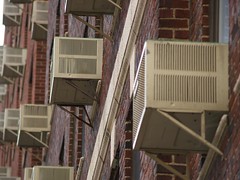 Once found in everything from whipped desert topping in a can to sore throat spray, CFCs were eventually found to react with protective layer of our atmosphere which blocks much of the sun’s harmful rays. They were eventually replaced with related compounds, HCFCs and HFCs. Although the substitutes were not harmful to the ozone layer, like the CFCs before them they have significant global warming potential.
Once found in everything from whipped desert topping in a can to sore throat spray, CFCs were eventually found to react with protective layer of our atmosphere which blocks much of the sun’s harmful rays. They were eventually replaced with related compounds, HCFCs and HFCs. Although the substitutes were not harmful to the ozone layer, like the CFCs before them they have significant global warming potential.
| Chemical | GWP | ODP | Life (yr) |
|---|---|---|---|
| CO2 | 1 | 0 | >10,000 |
| R12 (CFC) | 8100 | 1 | 100 |
| R22 (HCFC) | 1800 | 0.06 | 12 |
| R134a (HCFC) | 1300 | 0 | 14 |
| H2O | N/A | 0 | N/A |
Two weeks ago Canada, Mexico and the United States put forth a proposal to include these ‘Class II’ ozone depleting substances in the Montreal Protocol and phase-out their use. The proposed replacements are hydrocarbons, but their flammability complicates their use as general purpose substitutes, though these problems are not insurmountable. The Alliance for Responsible Atmospheric Policy, an industry association of HCFC/HFC producers and users, has some interesting background on the trade-offs relating to refrigerant selection, although they clearly have a vested interest in the matter.
There is another surprising alternative to these refrigerants, without resorting to the toxic ammonia of yore. If you glanced at the table above, you likely believed that the last entry was included for comparison. It was, but it turns out that water can also be used a refrigerant. Two years ago The Barr Foundation and the Cambridge Energy Alliance put forth an innocentive for a more efficient air conditioner. The winning submission was for a water-based system. A diagram of the novel solution is available on the InnoCentive blog.
